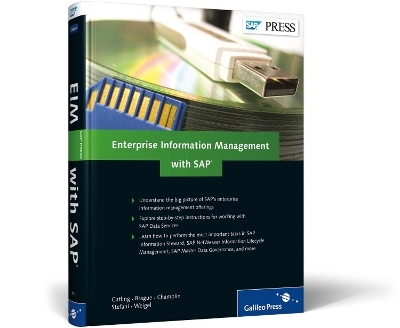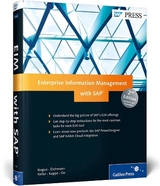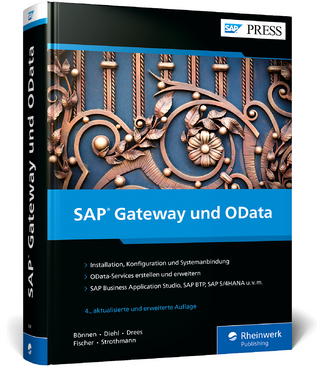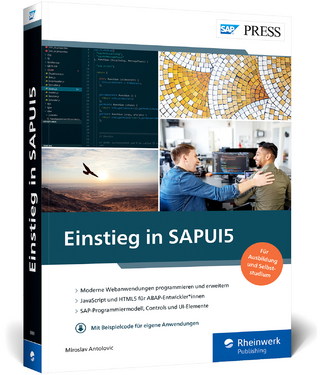
Enterprise Information Management with SAP
SAP Press (Verlag)
978-1-59229-414-5 (ISBN)
- Titel ist leider vergriffen;
keine Neuauflage - Artikel merken
Important EIM Tasks Follow along as the authors use a fictional company to walk you through step-by-step instructions and screenshots that teach you some of the most important tasks in SAP s EIM toolset. Structured and Unstructured Data Find out how SAP s EIM solutions can help you glean valuable information from text and other types of unstructured content. High Volumes of Data Get a basic understanding of how "big data" fits into the SAP picture, with discussions of SAP HANA and Hadoop.
Ginger Gatling is a senior product manager with SAP NetWeaver Management. She joined SAP in 1997 and spent her first seven years within Educational Services at SAP America. She taught more than 30 classes, including SAP Business Workflow, security, SAP CRM Middleware, integration, and administration courses. Additionally, she authored classes on SAP NetWeaver Business Warehouse security and system auditing. In 2004, she joined the SAP NetWeaver organization, working for SAP Labs, where she has served as product manager for BPM topics (including SAP Business Workflow, Universal Worklist, SAP NetWeaver Business Process Management), integration topics (SAP NetWeaver Process Integration), and other SAP NetWeaver topics as required. She is an active member in the Americas SAP User Group, serving on the board of her local North Texas ASUG Chapter, and she is a big fan and contributor to SDN and business process expert communities. Ginger has a master's degree in music theory from Northwestern University.
... Foreword ... 17 ... Preface ... 19 PART I ... SAP's Enterprise Information Management Strategy and Portfolio ... 25 1 ... Introducing Enterprise Information Management ... 27 1.1 ... Defining Enterprise Information Management ... 28 1.1.1 ... Example of Information Flow Through a Company ... 30 1.1.2 ... Types of Information Included in Enterprise Information Management ... 33 1.2 ... Common Use Cases for EIM ... 36 1.2.1 ... Operational EIM ... 37 1.2.2 ... Analytical EIM ... 39 1.2.3 ... Information Governance ... 40 1.3 ... Common Drivers for EIM ... 40 1.3.1 ... Operational Efficiency as a Driver of EIM ... 41 1.3.2 ... Information as an Organizational Asset ... 43 1.3.3 ... Compliance as a Driver of EIM ... 44 1.4 ... Impact of Big Data on EIM ... 45 1.5 ... SAP s Strategy for EIM ... 48 1.6 ... Typical User Roles in EIM ... 50 1.7 ... Example Company: NeedsEIM, Inc. ... 51 1.7.1 ... CFO Issues ... 52 1.7.2 ... Purchasing Issues ... 52 1.7.3 ... Sales Issues ... 52 1.7.4 ... Engineering and Contracts Issues ... 52 1.7.5 ... Information Management Challenges Facing NeedsEIM, Inc. ... 53 1.8 ... Summary ... 53 2 ... Introducing Information Governance ... 55 2.1 ... Introduction to Information Governance ... 56 2.2 ... Evaluating and Developing Your Information Governance Needs and Resources ... 58 2.2.1 ... Evaluating Information Governance ... 58 2.2.2 ... Developing Information Governance ... 62 2.3 ... Optimizing Existing Infrastructure and Resources ... 63 2.4 ... Establishing an Information Governance Process: Examples ... 65 2.4.1 ... Example 1: Creating a New Reseller ... 67 2.4.2 ... Example 2: Supplier Registration ... 68 2.4.3 ... Example 3: Data Migration ... 71 2.5 ... Rounding Out Your Information Governance Process ... 75 2.5.1 ... The Impact of Missing Data ... 75 2.5.2 ... Gathering Metrics and KPIs to Show Success ... 76 2.5.3 ... Establish a Before-and-After View ... 80 2.6 ... Summary ... 80 3 ... Big Data with SAP HANA and Hadoop ... 81 3.1 ... SAP HANA ... 81 3.1.1 ... Basics of SAP HANA ... 82 3.1.2 ... How SAP HANA Works ... 83 3.1.3 ... SAP HANA for Analytics and Business Intelligence ... 85 3.1.4 ... SAP HANA as an Application Platform ... 85 3.2 ... SAP HANA and EIM ... 86 3.2.1 ... Using SAP Data Services to Load Data into SAP HANA ... 87 3.2.2 ... EIM Solutions and SAP HANA ... 88 3.3 ... Big Data and Hadoop ... 88 3.3.1 ... The Rise of Parallel Processing Architectures ... 88 3.3.2 ... NoSQL: A New Kind of Database ... 89 3.3.3 ... Hadoop Primer ... 90 3.3.4 ... Hadoop: Enterprise Use Cases ... 95 3.4 ... SAP HANA and Hadoop ... 99 3.4.1 ... The V s: Volume, Variety, Velocity ... 99 3.4.2 ... SAP HANA: Designed for Enterprises ... 100 3.4.3 ... Hadoop as an SAP HANA Extension ... 100 3.5 ... EIM and Hadoop ... 100 3.5.1 ... ETL Data Services and the Information Design Tool ... 101 3.5.2 ... Unsupported: Information Governance and Information Lifecycle Management ... 101 3.6 ... Summary ... 102 4 ... SAP s Solutions for Enterprise Information Management ... 103 4.1 ... SAP Data Services as a Data Foundation ... 106 4.1.1 ... Basics of SAP Data Services ... 106 4.1.2 ... SAP Data Services Integration with SAP Applications ... 108 4.1.3 ... SAP Data Services Integration with Non-SAP Applications ... 111 4.1.4 ... Data Cleansing and Data Validation with SAP Data Services ... 112 4.1.5 ... Text Data Processing in SAP Data Services ... 115 4.2 ... SAP Information Steward ... 118 4.2.1 ... Data Profiling and Data Quality Monitoring ... 119 4.2.2 ... Metadata Analysis ... 122 4.2.3 ... Cleansing Rules ... 123 4.2.4 ... Business Glossary ... 125 4.3 ... SAP NetWeaver Master Data Management and SAP Master Data Governance ... 126 4.3.1 ... SAP NetWeaver Master Data Management ... 127 4.3.2 ... SAP Master Data Governance ... 127 4.4 ... SAP Solutions for Enterprise Content Management ... 130 4.4.1 ... Overview of SAP s ECM Solutions ... 133 4.4.2 ... SAP Extended Enterprise Content Management by OpenText ... 137 4.4.3 ... SAP Document Access by OpenText and Archiving by OpenText ... 140 4.5 ... SAP NetWeaver Information Lifecycle Management ... 142 4.5.1 ... Retention Management ... 146 4.5.2 ... System Decommissioning ... 147 4.6 ... SAP Solutions for Data Migration ... 150 4.6.1 ... SAP Data Migration Software ... 151 4.6.2 ... Predefined Content and Rules for Data Migration ... 153 4.6.3 ... Systems Migration ... 155 4.6.4 ... SAP Rapid Marts ... 155 4.7 ... Information Governance in SAP ... 156 4.7.1 ... Information Governance Use Scenario Phasing ... 157 4.7.2 ... Technology Enablers for Information Governance ... 159 4.8 ... NeedsEIM, Inc. and SAP s Solutions for EIM ... 162 4.9 ... Summary ... 163 5 ... Practical Examples of EIM ... 165 5.1 ... EIM Architecture Recommendations and Experiences by Procter and Gamble ... 165 5.1.1 ... Principles of an EIM Architecture ... 166 5.1.2 ... Scope of an EIM Enterprise Architecture ... 168 5.1.3 ... Structured Data ... 169 5.1.4 ... The Dual Database Approach ... 170 5.1.5 ... Typical Information Lifecycle ... 171 5.1.6 ... Data Standards ... 176 5.1.7 ... Unstructured Data ... 177 5.1.8 ... Governance ... 179 5.1.9 ... Role of the Enterprise Information Architecture Organization ... 184 5.2 ... Managing Data Migration Projects to Support Mergers and Acquisitions ... 184 5.2.1 ... Scoping for a Data Migration Project ... 185 5.2.2 ... Data Migration Process Flow ... 187 5.2.3 ... Enrich the Data Using Dun and Bradstreet (D&B) with Data Services ... 191 5.3 ... Evolution of SAP Data Services at National Vision ... 192 5.3.1 ... Phase 1: The Enterprise Data Warehouse ... 192 5.3.2 ... Phase 2: Enterprise Information Architecture Consolidating Source Data ... 193 5.3.3 ... Phase 3: Data Quality and the Customer Hub ... 195 5.3.4 ... Phase 4: Application Integration and Data Migration ... 197 5.3.5 ... Phase 5: Next Steps with Data Services ... 198 5.4 ... Recommendations for a Master Data Program ... 198 5.4.1 ... Common Enterprise Vision and Goals ... 198 5.4.2 ... Master Data Strategy ... 199 5.4.3 ... Roadmap and Operational Phases ... 199 5.4.4 ... Business Process Redesign and Change Management ... 199 5.4.5 ... Governance ... 200 5.4.6 ... Technology Selection ... 200 5.5 ... Recommendations for Using SAP NetWeaver Process Integration and SAP Data Services ... 201 5.5.1 ... A Common Data Integration Problem ... 201 5.5.2 ... A Data Integration Analogy ... 202 5.5.3 ... Creating Prescriptive Guidance to Help Choose the Proper Tool ... 203 5.5.4 ... Complex Examples in the Enterprise ... 204 5.5.5 ... When All Else Fails ... 206 5.6 ... Ensuring a Successful Enterprise Content Management Project by Belgian Railways ... 206 5.6.1 ... Building the Business Case ... 206 5.6.2 ... Key Success Factors for Your SAP Extended Enterprise Content Management by OpenText Project ... 213 5.7 ... Recommendations for Creating an Archiving Strategy ... 216 5.7.1 ... What Drives a Company into Starting a Data Archiving Project? ... 216 5.7.2 ... Who Initiates a Data Archiving Project? ... 217 5.7.3 ... Project Sponsorship ... 218 5.8 ... Summary ... 220 PART II ... Working with SAP's Enterprise Information Management Solutions ... 25 6 ... Getting to Know Your Data with SAP Information Steward ... 223 6.1 ... Cataloging Data Assets and Their Relationships ... 224 6.1.1 ... Configuring a Metadata Integrator Source ... 225 6.1.2 ... Executing or Scheduling Execution of Metadata Integration ... 227 6.2 ... Profiling Data ... 228 6.2.1 ... Configuration and Setup of Connections and Projects ... 229 6.2.2 ... Getting Basic Statistical Information about the Data Content ... 232 6.2.3 ... Identifying Cross-Field or Cross-Column Data Relationships ... 236 6.3 ... Monitoring and Assessing the Quality of Your Data ... 239 6.3.1 ... Defining Validation Rules Representing Business Requirements ... 241 6.3.2 ... Binding Rules to Data Sources for Data Quality Assessment ... 244 6.3.3 ... Executing Rule Tasks and Viewing Results ... 246 6.4 ... Summary ... 250 7 ... Introducing SAP Data Services ... 251 7.1 ... Data Integration Scenarios ... 252 7.2 ... SAP Data Services Platform Architecture ... 253 7.2.1 ... User Interface Tier ... 255 7.2.2 ... Server Tier ... 257 7.3 ... SAP Data Services Designer Overview ... 259 7.4 ... Creating Data Sources and Targets ... 263 7.4.1 ... Connectivity Options for SAP Data Services ... 263 7.4.2 ... Connecting to SAP ... 265 7.4.3 ... Connecting to Hadoop ... 268 7.5 ... Creating Your First Job ... 268 7.5.1 ... Create the Data Flow ... 268 7.5.2 ... Add a Source to the Data Flow ... 269 7.5.3 ... Add a Query Transform to the Data Flow ... 269 7.5.4 ... Add a Target to the Data Flow ... 270 7.5.5 ... Map the Source Data to the Target by Configuring the Query Transform ... 270 7.5.6 ... Create the Job and Add the Data Flow to the Job ... 271 7.6 ... Basic Transformations Using the Query Transform and Functions ... 272 7.7 ... Overview of Complex Transformations ... 275 7.7.1 ... Platform Transformations ... 275 7.7.2 ... Data Integrator Transforms ... 277 7.8 ... Executing and Debugging Your Job ... 280 7.9 ... Exposing a Real-Time Service ... 281 7.9.1 ... Create a Real-Time Job ... 282 7.9.2 ... Create a Real-Time Service ... 284 7.9.3 ... Expose the Real-Time Service as a Web Service ... 286 7.10 ... SAP Data Services and SAP HANA ... 287 7.11 ... Summary ... 288 8 ... Managing Data Quality with SAP Data Services ... 289 8.1 ... Data Cleansing ... 291 8.1.1 ... Data Parsing ... 292 8.1.2 ... Data Standardization ... 303 8.1.3 ... Data Correction ... 309 8.1.4 ... Data Validation ... 311 8.2 ... Data Enhancement ... 313 8.3 ... Data Matching ... 315 8.3.1 ... Rule-Based Matching Method ... 321 8.3.2 ... Weighted Scoring Matching Method ... 322 8.3.3 ... Combination Matching Method ... 323 8.3.4 ... Data Consolidation ... 330 8.4 ... Other Important Data Quality Capabilities ... 333 8.4.1 ... SAP Data Quality Management, Version for SAP Solutions ... 333 8.4.2 ... Data Quality Blueprints ... 335 8.4.3 ... Using Data Quality Beyond Customer Data ... 336 8.5 ... Summary ... 337 9 ... Monitoring Data Quality with Scorecards in SAP Information Steward ... 339 9.1 ... Components of a Data Quality Scorecard ... 340 9.2 ... Defining and Setting Up a Data Quality Scorecard ... 343 9.2.1 ... Modeling the High-Level Key Data Domains ... 343 9.2.2 ... Defining Data Quality Dimensions for the Key Data Domains ... 344 9.2.3 ... Adding the Validation Rules and Quality Dimensions for a Key Data Domain ... 346 9.2.4 ... Binding the Data Sources to the Data Quality Scorecard ... 348 9.3 ... Viewing the Data Quality Scorecard ... 349 9.3.1 ... Drilling Down into Data Quality Scorecard Details ... 350 9.3.2 ... Analyze Failed Record Sample Data ... 351 9.4 ... Identifying Data Quality Issue Impact or Data Quality Root Causes in the System Landscape ... 352 9.4.1 ... Reviewing Data Quality Issue Impact on Downstream Processes or Reports ... 353 9.4.2 ... Analyzing Data Quality Root Causes ... 355 9.5 ... Summary ... 355 10 ... Processing Text Data with SAP Data Services ... 357 10.1 ... Introduction to Text Data Processing Capabilities in SAP Data Services ... 359 10.1.1 ... Entity Extraction Transform Overview ... 361 10.1.2 ... How Extraction Works ... 362 10.2 ... Text Data Processing and NeedsEIM, Inc. ... 364 10.2.1 ... NeedsEIM, Inc. Pain Points ... 364 10.2.2 ... Using the Entity Extraction Transform ... 366 10.3 ... Summary ... 372 11 ... Migrating Data with SAP Data Services ... 373 11.1 ... Introduction to Data Migration ... 373 11.2 ... Data Migration Content Delivered by SAP Best Practices and Rapid Deployment Solutions ... 375 11.2.1 ... Data Migration Content ... 376 11.2.2 ... Architecture of SAP Best Practices and Data Services for Data Migration to SAP Applications ... 377 11.3 ... Migrating Customer Data to SAP ERP ... 379 11.3.1 ... Step 1: Download the Migration Content ... 379 11.3.2 ... Step 2: Install the Software ... 380 11.3.3 ... Step 3: Review the Jobs in Data Services ... 381 11.4 ... Systems Migration ... 383 11.5 ... Summary ... 384 12 ... Introducing SAP Master Data Governance ... 385 12.1 ... SAP Master Data Governance Overview ... 386 12.1.1 ... Deployment Options ... 388 12.1.2 ... Change Request and Staging ... 389 12.1.3 ... Process Flow in SAP Master Data Governance ... 391 12.2 ... Getting Started with SAP Master Data Governance ... 392 12.2.1 ... Data Modeling ... 393 12.2.2 ... User Interface (UI) Modeling ... 394 12.2.3 ... Data Quality and Search ... 395 12.2.4 ... Process Modeling ... 396 12.2.5 ... Data Replication ... 397 12.2.6 ... Key and Value Mapping ... 397 12.2.7 ... Data Transfer ... 399 12.2.8 ... Activities Beyond Customizing ... 399 12.3 ... Governance for Custom-Defined Objects: Example ... 400 12.3.1 ... Define New Models for Airline Entity and Currency Entity ... 401 12.3.2 ... Define Relationship Between the Airline and Currency Entity Types ... 402 12.3.3 ... Define User Interface ... 403 12.3.4 ... Link the User Interface Configuration to the Data Model ... 405 12.3.5 ... Create a Change Request Process ... 406 12.3.6 ... Assign Processors to Workflow ... 407 12.3.7 ... Test the New Airline Change Request ... 407 12.4 ... Rule-Based Workflows in SAP Master Data Governance ... 409 12.4.1 ... Classic SAP Business Workflow and Rule-Based Workflow using SAP Business Workflow and BRFplus ... 410 12.4.2 ... Designing Your First Rule-Based Workflow in SAP Master Data Governance ... 417 12.5 ... NeedsEIM, Inc.: Master Data Remediation ... 420 12.6 ... Summary ... 422 13 ... Introducing SAP NetWeaver Information Lifecycle Management ... 423 13.1 ... The Basics of Information Lifecycle Management ... 425 13.1.1 ... What Does ILM Mean? ... 425 13.1.2 ... Why Is ILM Needed? ... 425 13.2 ... Overview of SAP NetWeaver Information Lifecycle Management ... 426 13.2.1 ... Cornerstones of SAP NetWeaver ILM ... 428 13.2.2 ... Data Archiving Basics ... 429 13.2.3 ... ILM-Aware Storage ... 432 13.2.4 ... Architecture What You Need to Run SAP NetWeaver ILM ... 434 13.3 ... Managing the Lifecycle of Information in Live Systems ... 436 13.3.1 ... Audit Area ... 437 13.3.2 ... Data Destruction ... 439 13.3.3 ... Legal Hold Management ... 440 13.4 ... Managing the Lifecycle of Information from Legacy Systems ... 441 13.4.1 ... Preliminary Steps ... 442 13.4.2 ... Steps Performed in the Legacy System ... 444 13.4.3 ... Steps Performed in the Retention Warehouse System ... 444 13.4.4 ... Handling Data from Non-SAP Systems During Decommissioning ... 446 13.5 ... System Decommissioning Detailed Example ... 447 13.5.1 ... Data Extraction ... 448 13.5.2 ... Data Transfer and Conversion ... 452 13.5.3 ... Reporting ... 459 13.5.4 ... Data Destruction ... 463 13.6 ... Summary ... 466 14 ... Introducing SAP Extended Enterprise Content Management by OpenText ... 467 14.1 ... Capabilities of SAP Extended ECM ... 469 14.1.1 ... Data and Document Archiving ... 470 14.1.2 ... Records Management ... 471 14.1.3 ... Content Access ... 472 14.1.4 ... Document-Centric Workflow ... 472 14.1.5 ... Document Management ... 472 14.1.6 ... Capture ... 473 14.1.7 ... Collaboration and Social Media ... 473 14.2 ... How SAP Extended ECM Works with the SAP Business Suite ... 474 14.3 ... Integration Content for SAP Business Suite and SAP Extended ECM ... 476 14.3.1 ... SAP ArchiveLink ... 476 14.3.2 ... Content Management Interoperability Standard (CMIS) and SAP ECM Integration Layer ... 477 14.3.3 ... SAP Extended ECM Workspaces ... 479 14.4 ... Summary ... 485 ... The Authors ... 487 ... Index ... 495
| Erscheint lt. Verlag | 30.5.2012 |
|---|---|
| Verlagsort | Maryland |
| Sprache | englisch |
| Maße | 175 x 228 mm |
| Einbandart | gebunden |
| Themenwelt | Mathematik / Informatik ► Informatik ► Netzwerke |
| Informatik ► Weitere Themen ► SAP | |
| ISBN-10 | 1-59229-414-6 / 1592294146 |
| ISBN-13 | 978-1-59229-414-5 / 9781592294145 |
| Zustand | Neuware |
| Informationen gemäß Produktsicherheitsverordnung (GPSR) | |
| Haben Sie eine Frage zum Produkt? |
aus dem Bereich



